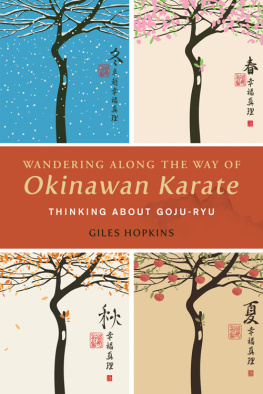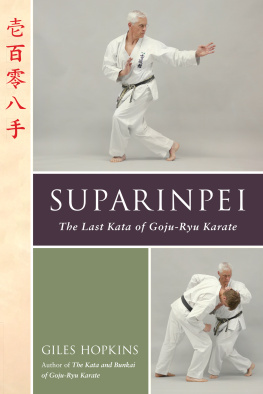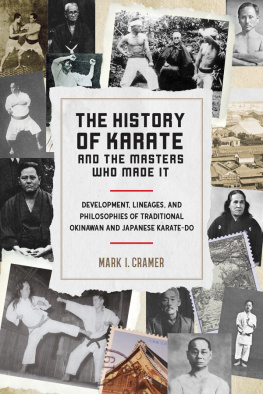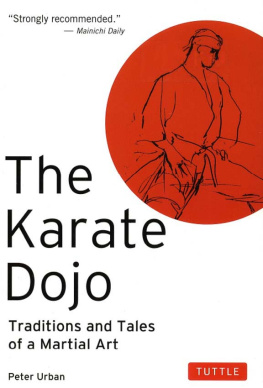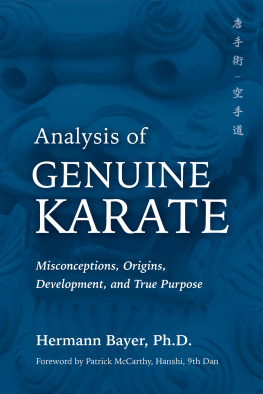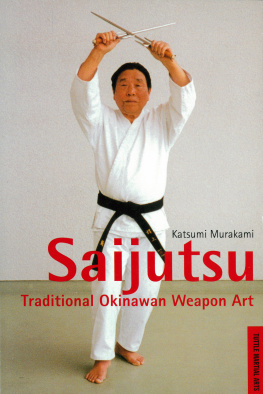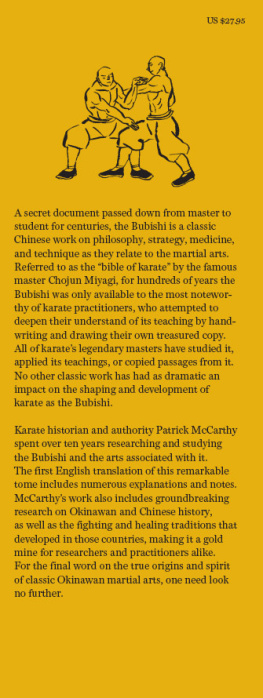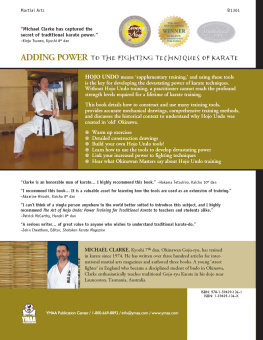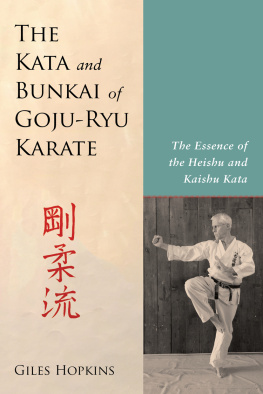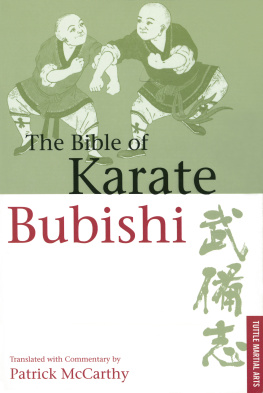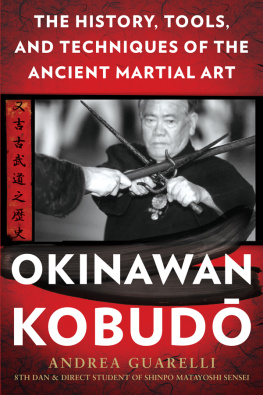Giles Hopkins - Wandering Along the Way of Okinawan Karate
Here you can read online Giles Hopkins - Wandering Along the Way of Okinawan Karate full text of the book (entire story) in english for free. Download pdf and epub, get meaning, cover and reviews about this ebook. year: 2020, genre: Religion. Description of the work, (preface) as well as reviews are available. Best literature library LitArk.com created for fans of good reading and offers a wide selection of genres:
Romance novel
Science fiction
Adventure
Detective
Science
History
Home and family
Prose
Art
Politics
Computer
Non-fiction
Religion
Business
Children
Humor
Choose a favorite category and find really read worthwhile books. Enjoy immersion in the world of imagination, feel the emotions of the characters or learn something new for yourself, make an fascinating discovery.
- Book:Wandering Along the Way of Okinawan Karate
- Author:
- Genre:
- Year:2020
- Rating:3 / 5
- Favourites:Add to favourites
- Your mark:
- 60
- 1
- 2
- 3
- 4
- 5
Wandering Along the Way of Okinawan Karate: summary, description and annotation
We offer to read an annotation, description, summary or preface (depends on what the author of the book "Wandering Along the Way of Okinawan Karate" wrote himself). If you haven't found the necessary information about the book — write in the comments, we will try to find it.
Wandering Along the Way of Okinawan Karate — read online for free the complete book (whole text) full work
Below is the text of the book, divided by pages. System saving the place of the last page read, allows you to conveniently read the book "Wandering Along the Way of Okinawan Karate" online for free, without having to search again every time where you left off. Put a bookmark, and you can go to the page where you finished reading at any time.
Font size:
Interval:
Bookmark:

Copyright 2020 by Giles Hopkins. All rights reserved. No portion of this book, except for brief review, may be reproduced, stored in a retrieval system, or transmitted in any form or by any meanselectronic, mechanical, photocopying, recording, or otherwisewithout written permission of the publisher. For information contact Blue Snake Books c/o North Atlantic Books.
Published by Blue Snake Books, an imprint of North Atlantic Books Berkeley, California
Cover design by Rob Johnson
Cover art gettyimages.com/paseven
Interior design by Happenstance Type-O-Rama
Printed in the United States of America
Wandering Along the Way of Okinawan Karate: Thinking about Goju-Ryu is sponsored and published by the Society for the Study of Native Arts and Sciences (dba North Atlantic Books), an educational nonprofit based in Berkeley, California, that collaborates with partners to develop cross-cultural perspectives, nurture holistic views of art, science, the humanities, and healing, and seed personal and global transformation by publishing work on the relationship of body, spirit, and nature.
North Atlantic Books publications are available through most bookstores. For further information, call 800-733-3000 or visit our websites at www.northatlanticbooks.com and www.bluesnakebooks.com.
PLEASE NOTE: The creators and publishers of this book disclaim any liabilities for loss in connection with following any of the practices, exercises, and advice contained herein. To reduce the chance of injury or any other harm, the reader should consult a professional before undertaking this or any other martial arts, movement, meditative arts, health, or exercise program. The instructions and advice printed in this book are not in any way intended as a substitute for medical, mental, or emotional counseling with a licensed physician or healthcare provider.
Library of Congress Cataloging-in-Publication Data
Names: Hopkins, Giles, 1951 author. | Society for the Study of Native Arts and Sciences.
Title: Wandering Along the Way of Okinawan Karate : Thinking About Goju-Ryu / Giles Hopkins.
Other titles: Okinawan karate
Description: First Edition. | Berkeley, California : North Atlantic Books, 2020. | Includes index.
Identifiers: LCCN 2019037565 | ISBN 9781623174477 (Trade Paperback) | ISBN 9781623174484 (eBook)
Subjects: LCSH: KarateJapanOkinawa Island. | Martial artsJapanOkinawaHistory. | Hand-to-hand fighting, Oriental.
Classification: LCC GV1114.3 .H666 2020 | DDC 796.815/309522dc23
LC record available at https://lccn.loc.gov/2019037565
This book includes recycled material and material from well-managed forests. North Atlantic Books is committed to the protection of our environment. We print on recycled paper whenever possible and partner with printers who strive to use environmentally responsible practices.
To all those who walked this way before me and those whom Ive met along the way.
I am profoundly grateful to all my teachers: Kimo Wall, who taught me kata; Gibo Seiki, who corrected my kata; and Matayoshi Shinpo, who told me, Maybe scoshi mo renshu.
Kimo Sensei once said to me, Giles san, dont follow me; follow Goju. And I have tried to do that. It hasnt always taken me to places I expected, but it has always been gratifying.
I am also very thankful that I have had such good people to train with over the years. Especially Ivan Troescher (Siff) and Bill Diggle. I began what I think of as a journey of discovery in the study of the classical kata of Goju-ryu with Ivan over twenty years ago. It has continued with Bill for almost that long.
I also want to thank Jeff Cook, who took most of the application photographs for this book, and my son, Noah, who helped with some of the solo pictures.
And lastly, of course, I would like to thank the editors at North Atlantic Books for believing this was a worthwhile book, and my family: Martha, Emily, Phoebe, and Noah. I couldnt do any of this without all of you.
The starlings are back. They come in the afternoon usually. Hundreds of them sweep down in noisy gangs like vigilantes from the Old West, storming into town, riding roughshod and shooting up the local saloon before they ride off, perching in my neighbors giant catalpa tree as if they were surveying the territory, deciding what field or grassy knoll to plunder next.
I dont see these birds off in the forests, though Im not exactly sure why. Perhaps theyre wanderers or more given to this marauding lifestyle. After all, theyre an invasive species, introduced to America back in 1890 by the American Acclimatization Society, led by Eugene Schieffelin, who, a big fan of the Bards, had decided that the mission of the society should be to introduce to America every bird mentioned in Shakespeares playsa notion so wonderfully romantic and misguided at the same time. Thankfully, they dont seem to feel at home in the woods. Besides, I dont know whether the woodland birds would tolerate all this racket. There must be an unwritten agreement among all the forest animals that the woods are a quiet zone, a sort of natural library, a place to think. At least thats how I look at it.
Ive spent the last few years, ever since I retired from teaching, walking in the woods of the Fitzgerald Lake Conservation Area and the Mount Tom State Reservation. The trails wind through stands of oak and maple and hickory and hills covered with hemlock and white pine. There are swamps and lakes and rocky bluffs. Here is where, for an hour or two, I can escape the rancorous noise of civilization and let my mind wander. And what I often find myself thinking about is the martial arts in general and the classical (or koryu) kata of Okinawan Goju-ryu karate in particular.
Of course, when I first began training in the martial arts, back in the early 1970s, I didnt actually think about karate. I stood in line with everyone else and just followed the teacher. I learned the basics and how to count in Japanese and how to fold my gi after training. I learned how to tie a belt, eat with chopsticks, and sit for long periods of time in seiza, listening to stories about all of the old teachers and what training was like in Okinawa in the old days. And, of course, I learned katatraining kata like Gekisai and Gekiha and Kakuha, classical kata like Sanchin and Seipai and Suparinpei, and what my teacher called gift kata like Naihanchin and Sochin and Hankutsuru No Mai.
In addition to the empty-hand kata, there were the weapons kata of Okinawan kobudo because my teacher, Kimo Wall, had also spent a good deal of time with Matayoshi Shinpo senseithe well-known weapons teacher and National Treasure of Okinawa. We trained bo, sai, tonfa, nunchiyaku, eaku, kwa, kama, and sansetsukon. I learned how to wrap sai handles, how to string the nunchiyaku, and how to cut the tonfa handle down so that it was a custom fit to my own hand. We broke weapons doing demonstrations, tore our gi in training, and wore out belts, but I never thought very much about what I was doing.
When I look back on it now, I realize that the training was hard, but it was also very basic. We trained five days a week for two hours each day. Sometimes, of course, we would train later, and often we would train on weekends because a few of us shared a house with Kimo sensei. We did a lot of conditioning and a lot of basics (kihon). Sometimes we would count around the entire dojo of fifty or sixty students, each student counting ten, doing front kicks (mae geri). We would regularly do ten sets of ten head punches
Next pageFont size:
Interval:
Bookmark:
Similar books «Wandering Along the Way of Okinawan Karate»
Look at similar books to Wandering Along the Way of Okinawan Karate. We have selected literature similar in name and meaning in the hope of providing readers with more options to find new, interesting, not yet read works.
Discussion, reviews of the book Wandering Along the Way of Okinawan Karate and just readers' own opinions. Leave your comments, write what you think about the work, its meaning or the main characters. Specify what exactly you liked and what you didn't like, and why you think so.

